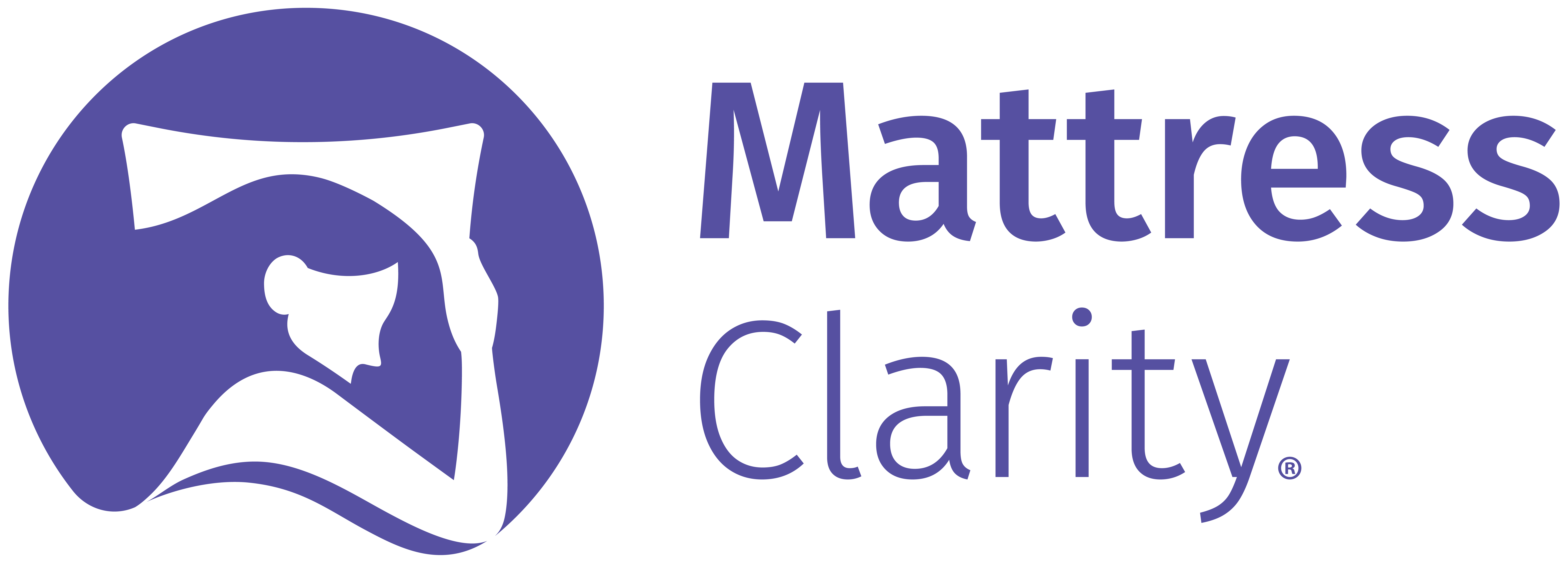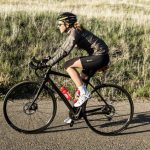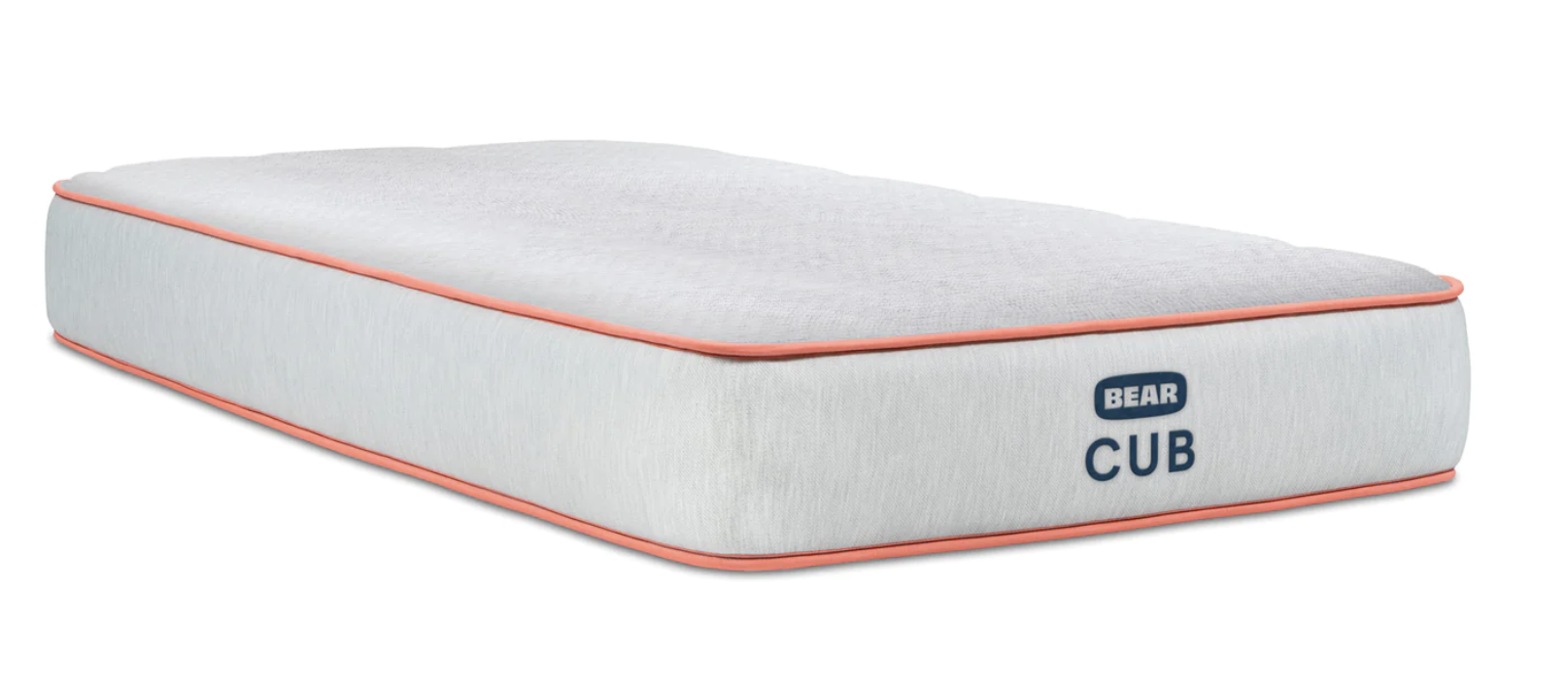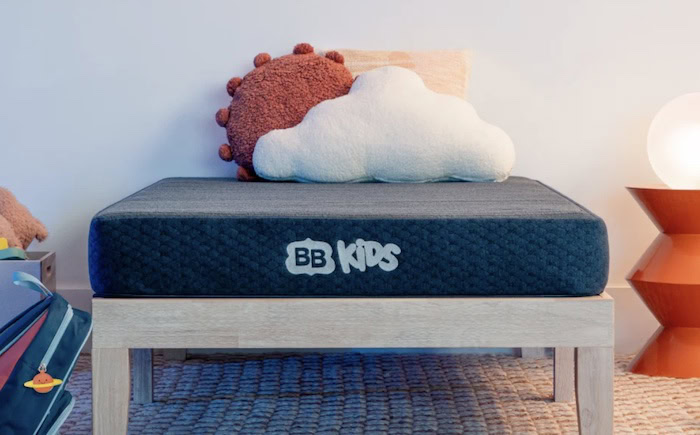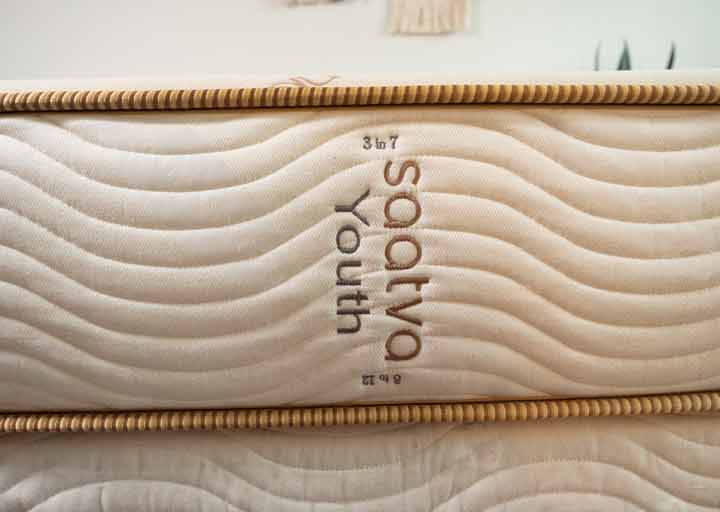Kids’ mattresses have come a long way from the one-size-fits-all options of decades past. Today’s models deliver on the things that matter most for growing bodies — and there are plenty of options from popular brands. Beyond an appropriate firmness and sturdy edges, many kid beds are designed to keep little bodies from overheating and comfortably aligned no matter what positions they work themselves into.
To write this review of the Bear Cub, we assessed this fun-size mattress through the eyes of a child — kind of. The Mattress Clarity team has evaluated more than 5,000 mattresses and sleep products over the past seven years, and we have the testing chops to make recommendations about what kind of sleepers are likely to do best on specific beds. That includes kids!
Our expert team of mattress testers considered key details like firmness, pressure relief, cooling ability, motion transfer, and edge support to determine whether the Bear Cub mattress is equipped to handle the unique sleep needs of kids, from rambunctious toddlers to lanky tweens. After testing the high-quality hybrid mattress in our studio, we found it pleasingly supportive, with exactly what you need to maintain proper posture and alignment as kids grow. Keep reading to see how the Bear Cub mattress fared in the rest of our testing, and whether it might be a dreamy spot for your kids to spend the night.
The Bear Cub is a hybrid mattress with a little extra appeal for children, since they can choose which color they’d like (Arctic Blue or Salmon). The bed has pretty perfect edge support and pressure relief, but it isn’t flippable, unlike many competitors.
Bear Cub Kids Mattress Performance: My Overall Rating
It may be a high-quality mattress meant for kids, but we assessed the Bear Cub Kids Mattress the way we do all mattresses — with a rigorous testing methodology that’s been medically reviewed by our chief medical advisor Dr. Raj Dasgupta, MD, FACP, FCCP, FAASM. After carefully reviewing the Cub’s performance in categories like pressure relief, edge support, cooling ability, and customer experience, we ultimately scored it 4.8 out of 5 stars. The mattresses performed beautifully across the board, and we’re sharing specifics below.
Before you continue, hover your cursor over the individual testing categories below for a brief description.
I Recommend the Bear Cub Kids Mattress for…
- Side and back sleepers. The medium-firm feel is softly contouring for the shoulders, hips, and low back, so kids who spend the night on their sides and backs should be nicely supported.
- Kids who sleep warm should be comfortable on the Bear Cub, thanks to its airflow-promoting coils and gel-infused memory foam.
- Very small children who are transitioning from a crib may benefit from a mattress that’s a little firmer for more stability.
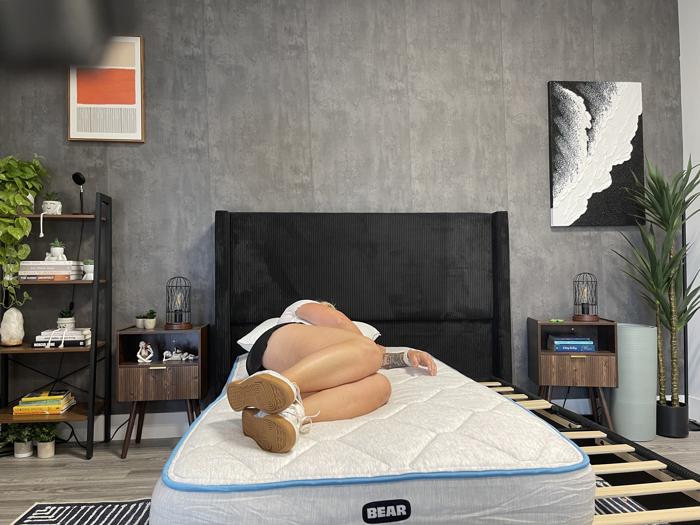
I Don’t Recommend the Bear Cub Kids For…
- Heavier stomach sleepers who are a little older, in the 8 to 12 years old range, may find this kid bed a hair too soft, since it doesn’t offer dual firmness or any kind of zoned support.
- Kids prone to accidents won’t benefit from any kind of stain resistance, and the cover can’t be removed for easy machine washing either.
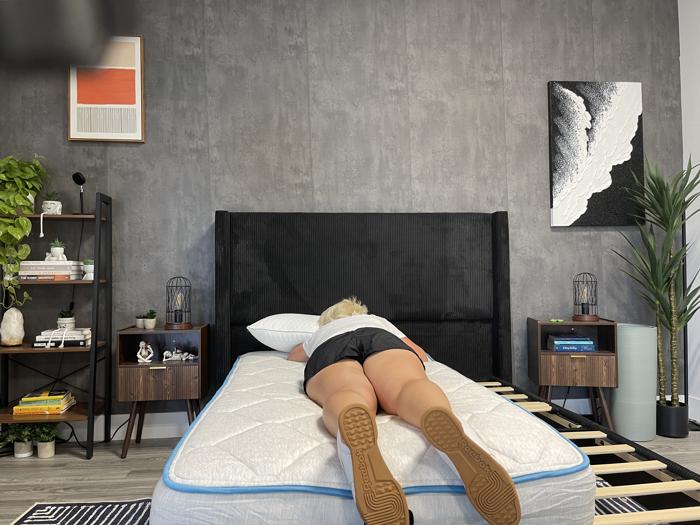
How Firm Is the Bear Cub Kids Mattress?

When we talk about mattress firmness, we’re describing how soft or firm a mattress feels when we lie on it. The tricky part of that is how much individual body type and sleep position influence that perception. That’s why the very same mattress can feel firmer to a lightweight side sleeper than it does to a heavyweight back sleeper. With kids especially, many mattresses designed with adult sleepers in mind can feel quite a bit firmer, because kids just don’t have the weight to sink in as deeply.
The mattress firmness rating can be a helpful guideline that offers a general idea of how hard or soft a mattress feels. It’s based on a scale of 1 to 10—1 is the softest, and 10 is the firmest. A mattress with a rating of 6.5/10 is considered a true medium-firm, which is largely considered universally comfortable for adults. For kids, however, a mattress that’s a little firmer is usually recommended because it supports a growing child by helping them maintain healthy spinal alignment.
Mattress Clarity tester Sosha Lewis evaluated the Bear Cub to get a sense of its feel. She’s an average-weight sleeper at roughly 165 pounds, so her perception is going to be a little different than many lightweight kids. When she tested the hybrid mattress on her side, Sosha was impressed. “This is marketed towards kids, but it is just fine for adults,” she said. “I liked how the memory foam gave me some good pressure relief and the coils kept me aligned.”
It was the same story on her back. “I really enjoyed this,” she said, adding that while she wouldn’t choose it for her bed, it would work really well for an extended stay somewhere if she were a back sleeper. “I felt balanced and even,” she noted. “The foams did a good job contouring to my lower back.” On both her side and her back, she gave the Bear Cub a firmness rating of 6.5/10. It’s likely that younger kids or really lightweight sleepers will find it a touch firmer.
When Sosha flipped to her stomach, she was reminded that the Bear Cub Kids Mattress is indeed a kids’ mattress. “This position was definitely not my favorite,” she shared. “It was hard on my chest and I had a u-shape in my lower back. I don’t think most kids would have the same reaction, but it’s not for me.” It’s probably going to feel a little firmer for most kids, but we’d still steer older or heavier kids who prefer to sleep on their stomachs to a mattress with a firmer feel.
How Well Did the Bear Cub Kids Mattress Perform?
Comparisons can be really helpful when you want to see how well a particular mattress stacks up against the rest. Below, find our take on the Bear Cub against other mattresses we’ve tested.
| Test | Performance | Average |
| Firmness | 6.5/10 – Medium-firm | 6.7/10 – Medium-Firm |
| Side Sleeper Comfort | Excellent | Good |
| Back Sleeper Comfort | Excellent | Good |
| Stomach Sleeper Comfort | Good | Good |
| Pressure Relief | 5/5 | 3.9 |
| Edge Support | 5/5 | 4.1 |
| Cooling | 4/5 | 3.8 |
| Noise | 5/5 | 4.5 |
| Trial Period | 4/5 | 4.2 |
| Warranty | 4.5/5 | 4.6 |
How Does the Bear Cub Kids Mattress Feel for Different Body Types and Sleeping Positions?
It’s not just body weight that affects how a mattress feels. How you prefer to sleep also plays a role, and children are no different. Most kids fall into the lightweight sleeper category (under 130 pounds), and side sleeping is one of the most common positions. But younger kids in particular tend to move around quite a bit white they sleep.
While the Bear Cub mattress is intended to be a kid bed, it may see the occasional adult sleeper in a guest room or RV (or just a parent who fell asleep trying to get their child to bed). With that in mind, we’ve broken down how the Cub is likely to perform for different sleeper types based on weight class and sleeping position.
| Sleeper Weight | Side Sleepers | Back Sleepers | Stomach Sleepers |
| Light (under 130 lbs) | Excellent | Excellent | Good |
| Average (130-230 lbs) | Good | Good | Unpleasant |
| Heavy (over 230 lbs) | Unpleasant | Unpleasant | Unpleasant |
Average-weight Tester – 130 to 230 lbs
“Big fan on my back. The foam and coils were a great combination. They kept me supported and feeling balanced,” said mattress tester Sosha Lewis.
Bear Cub Kids Mattress In-Depth Test Results
Pressure Relief
Pressure relief is a big deal in mattresses for adults. With more body weight pressing into the mattress, there’s a greater risk of pressure building in sensitive areas, like the hips and shoulders. That’s what creates aches and pains that can be serious enough to disrupt your sleep and make you irritable in the morning. For most kids, pressure relief isn’t nearly as important. Most kids lack the body weight to create those kinds of pressure points. The focus for kids should be on proper spinal support, which is what keeps growing bodies aligned. That’s why adults may benefit from softer comfort layers, but kids usually do best on a firmer surface.
When Sosha tested the Bear Cub mattress on her side, she thought it did a great job of keeping her comfortable and supported.. “I was impressed with this on the side, and I think kid side sleepers will do great,” she said. “The memory foam provides nice contouring and the coils keep me aligned.” Again, lighter kid sleepers are likely going to find the Bear Cub a little firmer, but since support is more important than pressure relief at this stage, we scored the mattress 5 out of 5 stars here.
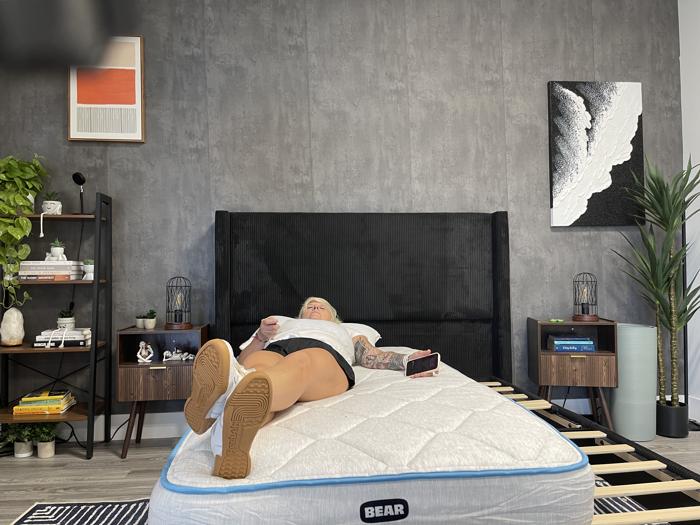
The Bear Cub earned the same excellent score when Sosha flipped to her back. “I’m a big fan on my back,” she said, noting that the combination of the foam and the coils below works really well. Sosha describes feeling both supported and balanced, which is pretty ideal if you’re a back sleeper.
Edge Support
Kids, especially those on the younger side, tend to be pretty impressive contortionists and acrobats in their sleep. That makes a bed with sturdy edges really important, ensuring that even kids who get dangerously close to the side aren’t likely to slide right off in the middle of the night. Since kids’ mattresses are on the smaller side—usually limited to twin, twin XL, and full size—good edge support means a little more space to move around. When we assessed the Bear Cub, we were impressed with how well its edges performed and gave it another 5 stars out of 5.
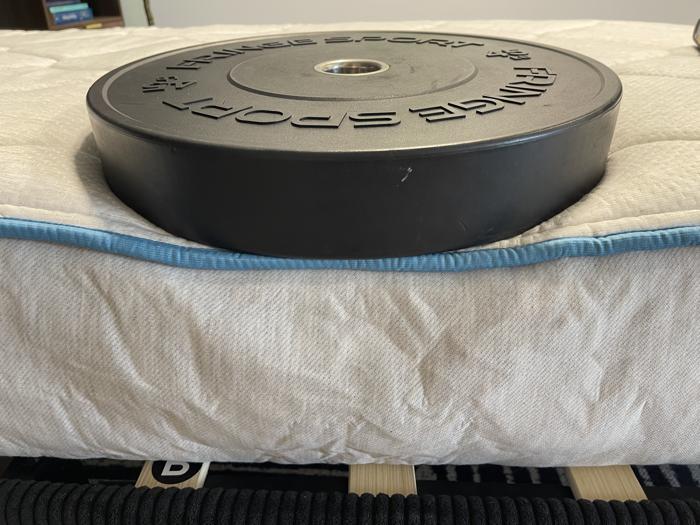
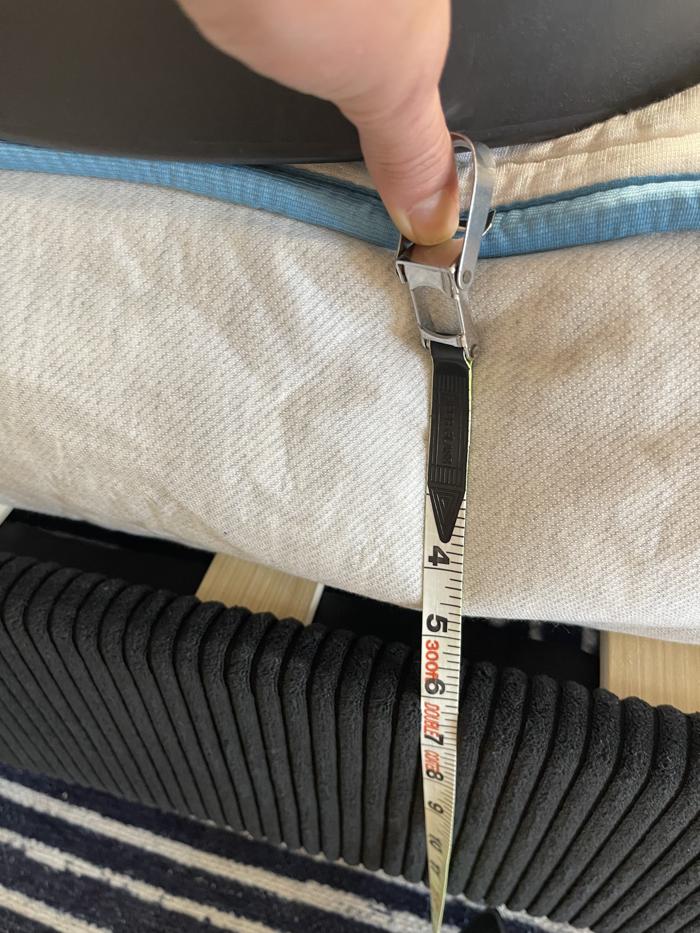
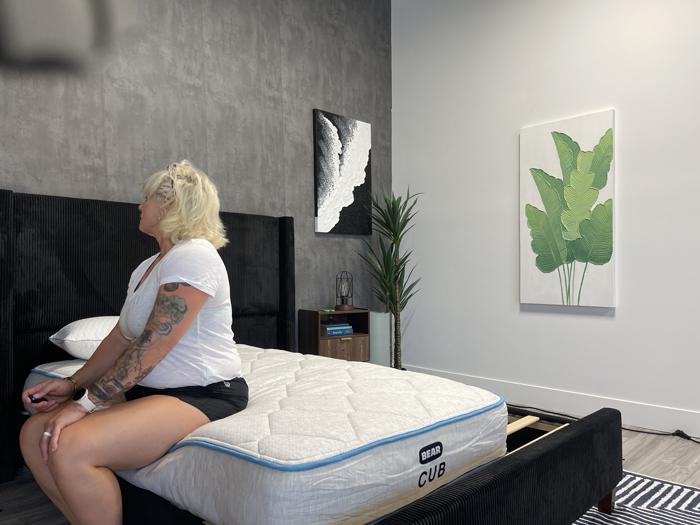
We completed a few different tests to make our ruling. Sosha used a tape measure to check the height of the Bear Cub. It measured 9.5 inches. Then she stacked a 45-pound weight right on the edge of the bed and measured how far the layers collapsed. It sank 2 inches, which is great. The innerspring coils in hybrid mattresses tend to provide better edge support than in all-foam mattresses, and that was the case here.
In the second test, Sosha sat on the side of the Bear Cub mattress and moved to a standing position, paying close attention to how stable she felt throughout. “The edge support was pretty great, especially considering I weigh substantially more than the target audience,” she reported. “I was very impressed. It was easy to get up and down, and a kid should have no problem at all.”
In the third and final edge support test, Sosha lay on the bed along the side and assessed its stability in all three sleep positions. “I was equally impressed with how supported I was lying on my back, side, and stomach,” she said. “Little ones should have no issues at all.”
Cooling
Children tend to be more noticeably warm when they sleep, largely due to a faster metabolism that generates more body heat and the fact that they’re usually more active sleepers. Their growing bodies are also still learning how to efficiently regulate temperature, so they’re more likely to overheat at night if they’re sleeping with materials that are known for trapping heat. This makes a mattress that breathes well critical.
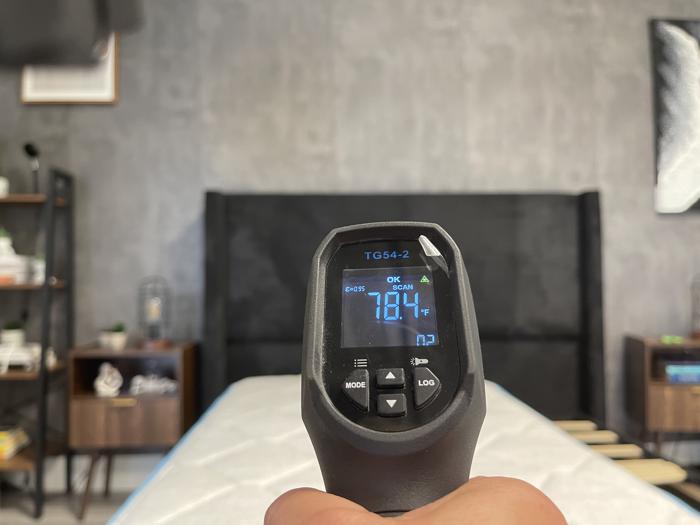
While the Bear Cub didn’t knock it out of the park in this category, it actually performed a little better than expected. It’s a hybrid mattress, which makes it more breathable than a bed with an all-foam construction, but one of its layers is memory foam, a material known for heat retention. In the Cub, this layer uses gel memory foam to help combat the tendency to trap heat, and it seems to do the trick.
Sosha used a thermal gun to measure the surface temperature of the Bear Cub. It was 78.4. She then spent five minutes lying on the mattress before taking a second read. The sleep surface showed an increase of 6.9 degrees to 85.3. Usually, we like to see an increase of 5 degrees or less, so this is a little high.
While she rested on the Cub, Sosha said it lacked any sort of coolness to the touch. On the other hand, she noted that it was extremely hot in the studio on testing day. “Even as hot as it was, I didn’t notice the bed heating up,” she said. Sosha gave the mattress 4 stars out of 5 for its cooling ability. Based on this, we think it’s a reasonable option for most kids, unless they’re prone to excessively overheating at night.
Noise
The Bear Cub stayed pleasingly silent during all our tests, and that was the case when we tried to get it to hiss or creak or otherwise make some sort of sound. Restless kids who toss and turn all night should be able to do so without the mattress startling them awake.
Bear Cub Kids Mattress Customer Experience Scores
While parents are likely to focus on features that pertain to their children, some parts of the mattress shopping experience call squarely on the grownups. Here’s an overview of the fine print if you decide that the Bear Cub mattress seems like a good fit.
Trial Period
Bear offers a 120-night sleep trial on its Cub mattress. It’s not as generous as the 365-night trials offered by some competitors, but four months should be more than enough time for you and your child to determine whether the Bear Cub is getting the job done.
Like just about every mattress company, Bear asks that you give the mattress 30 days before initiating a return for a full refund. It can take time for bodies to adjust to a new bed, and that’s true for kids as well (especially when they’re making the exciting leap from a crib to a real bed).
Warranty
The Bear Cub Kids Mattress is protected by a limited lifetime warranty. This applies to mattresses purchased on or after February 1, 2025. In the event of a covered manufacturer or material defect during the first 10 years of ownership, the brand offers repairs or a replacement at no cost to you. From year 11 on, Bear offers prorated coverage in lieu of a full refund.
Unboxing and Moving
The Bear Cub is a bed in a box, so it ships compressed, rolled, wrapped in plastic, and placed in a big cardboard box. Since it’s a kids’ mattress, it’s not comparable in size or weight to, say, a king, and it’s fairly manageable to get it from the front door to your kid’s room. Even the largest size weighs just 70 pounds.
Readiness After Unboxing
Once you puncture the plastic wrapping, the Bear Cub Kids Mattress starts decompressing immediately with a slight hissing sound. It’s ready to sleep on as soon as it’s fully expanded, which can take between 24 and 48 hours depending on how long it was in a box.
Since it’s made with memory foam, there is some mild off-gassing. It dissipated quickly during our testing.
Bear Cub Kids Mattress Construction
Beyond considering performance metrics and customer policies, part of our testing process involves an up-close-and-personal look at what’s inside the mattresses we review. To do that, we cut into the cover so we can look at the layers and construction. In the Bear Cub, we found two layers of foam and a layer of springs, all of which seemed durable and supportive.
Mattress Height and Weight
The Bear Cub comes in twin and full sizes. It measures 8.5 inches tall. The full size mattress is heavier at 70 pounds, while the twin mattress is 50 pounds.
Materials
This kids’ mattress has a hybrid design that combines memory foam layers with innerspring coils. It’s fiberglass-free and GREENGUARD Gold certified, which means it’s met stringent standards for low emissions. The foams in the Bear Cub are CertiPUR-US certified, which means they’re free of ozone depleters, heavy metals, formaldehyde, phthalates, and other potentially harmful chemicals and compounds. Another bonus: This type of eco-friendly foam is more durable and less likely to deteriorate prematurely.
Layers
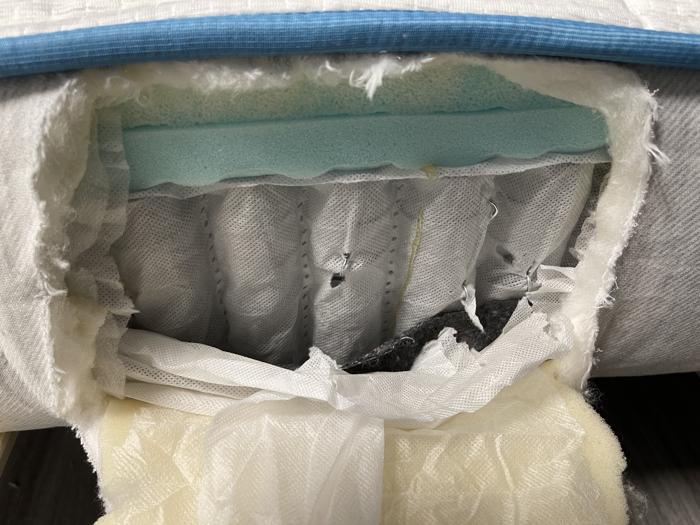
The Bear Cub is simply constructed. The quilted cover is woven with Tencel fibers for softness and breathability. Just below is a gel memory foam layer that contours and combats heat retention. Next is a dense responsive foam layer for spinal alignment. The support layer comes from 6-inch innerspring coils that are reinforced on the edges (that’s why the Cub’s edge support is so great!).
For a bonus touch, the piping around the top and bottom cover is available in a choice of two colors.
How to Try and Buy the Bear Cub Kids Mattress
Bear is an online mattress company, so all of its mattresses can be purchased at its website, bearmattress.com. Some online retailers, including Amazon, also carry Bear mattresses.
The brand has partnered with showrooms across the country, which means you may be able to find a Bear Cub mattress locally as well. Check the location finder feature on the Bear website to find a dealer in your area.
Bear Cub Kids Mattress Prices & Sizes
The Bear Cub Kids mattress is only available in twin and full sizes. Both options come in two color options for the piping around the perimeter of the top and bottom covers. Choose between salmon and Arctic blue.
| Size | Price |
| Twin | $784.00 |
| Full | $927.00 |
How The Bear Cub Kids Mattress Compares
Plenty of recognizable mattress brands offer kids’ models these days, and it can be helpful to compare them for an idea of strengths and weaknesses. Here’s how the Bear Cub Kids Mattress stacks up to three other popular mattresses for kids.
- Nectar Kids Mattress – More reasonably priced
- BB Kids – Firmer feel for stomach sleepers
- Saatva Youth Mattress – Upgraded spinal support
| Rating |
|
|
|
|
|---|---|---|---|---|
| Firmness |
Medium-firm: 6.5/10
|
Firm: 8/10
|
Firm: 7.5/10
|
Medium-firm: 6.5/10
|
| Material |
Hybrid
|
Foam
|
Foam
|
Innerspring
|
| Cooling |
—
|
—
|
—
|
|
| Best For |
Kids
|
Back Sleepers,
Stomach Sleepers, Kids |
Kids
|
Back Sleepers,
Stomach Sleepers, Hot Sleepers |
|
|
Bear Cub Kids vs. Nectar Kids
The Nectar Kids Mattress has a lot going for it. It has a flippable design with dual firmness, so it’s designed to grow with your child as they get bigger and their sleep preferences shift a little. One side feels like a 7.5/10 in firmness, and the other is 8/10. The Nectar Kids also has a removable cover, which works well with young kids who may still be having accidents at night.
Like the Bear Cub, the Nectar Kids comes in twin and full sizes only. It didn’t score as well as the Bear Cub in pressure relief or edge support, but it outperformed the Cub in our cooling tests. That’s surprising given its all-foam mattress construction, which tends to stifle airflow.
As for pricing, the Nectar is the more affordable mattress of the two. It’s priced at $299 and $399 depending on size, which is a significant savings over the Bear Cub. Even on sale, a twin retails for $549, while a full is $649.
Read more in our Nectar Kids review.
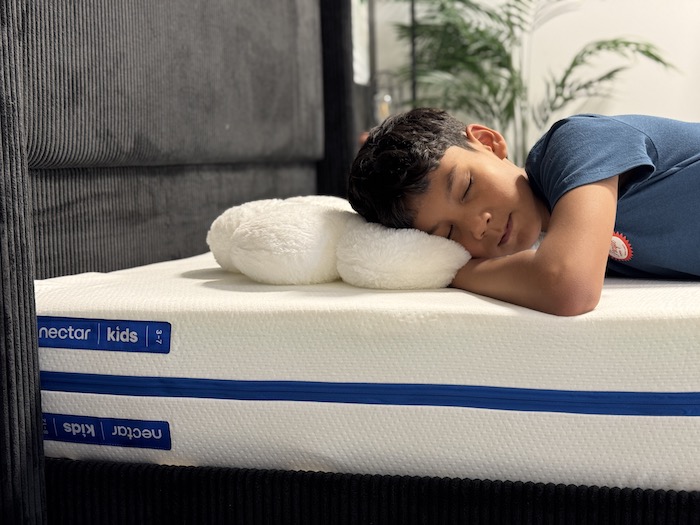
Bear Cub Kids vs. Brooklyn Bedding Kids
Like the Bear Cub, the Brooklyn Bedding Kids Mattress comes in a single firmness. But while the Bear Cub has a medium-firm feel that works well for side and back sleeping, the BB Kids Mattress is quite a bit firmer. During testing, we rated it 8/10, so it’s a better fit for strict back or stomach sleepers and kids on the younger side. After about 8 years old, some kids do better with a little more softness.
The all-foam BB Kids has a stain-resistant hypoallergenic cover (a nice touch in a kids’ mattress and good resistance against allergens) and strong edge support. But the Bear Cub offers better pressure relief and cooling, which is worth keeping in mind if your child sleeps warm.
Both mattresses have the same 120-night sleep trial and limited lifetime warranties. But Brooklyn Bedding does charge a $99 return fee. If you’re on a tight budget, the BB Kids Mattress is the more economical option and priced between $265 and $332 depending on the size. It comes in twin and full mattress sizes just like the Bear, but it’s also available in a twin XL. That’s ideal if your child is on the taller side.
Read more in our Brooklyn Bedding Kids review.
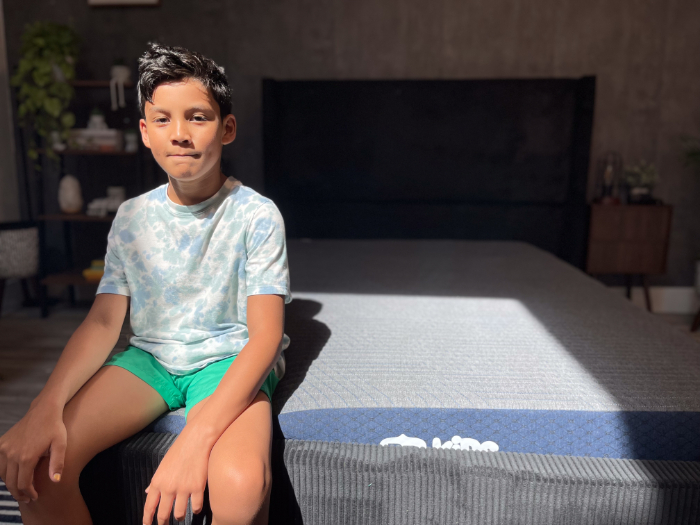
Bear Cub Kids vs. Saatva Youth
The Saatva Youth Mattress has a lot of upgrades for a child’s mattress. The flippable model includes dual firmness options and enhanced spinal support to suit the needs of younger and older kids alike. That’s in addition to the lumbar zone quilting sewn into the organic cotton cover, which is treated to resist water and inhibit the growth of bacteria, mold and mildew. The Saatva kids’ mattress is on the taller side at 10 inches, and it comes in twin, twin XL, and full sizes.
During testing, the Saatva Youth scored well in pressure relief and edge support, but the Bear Cub edged it out in both categories. Both mattresses got 4 stars out of 5 for cooling. But when it came to customer experience, the Saatva Youth earned full marks. That’s thanks to its generous 365-night sleep trial, white glove delivery, and lifetime warranty.
As you may have guessed, a premium kids’ mattress comes with a premium price tag. Before discounts and sales, a full-size Saatva Youth mattress is $1,059. A twin is $799 and a twin XL is $939.
Read more in our Saatva Youth review.
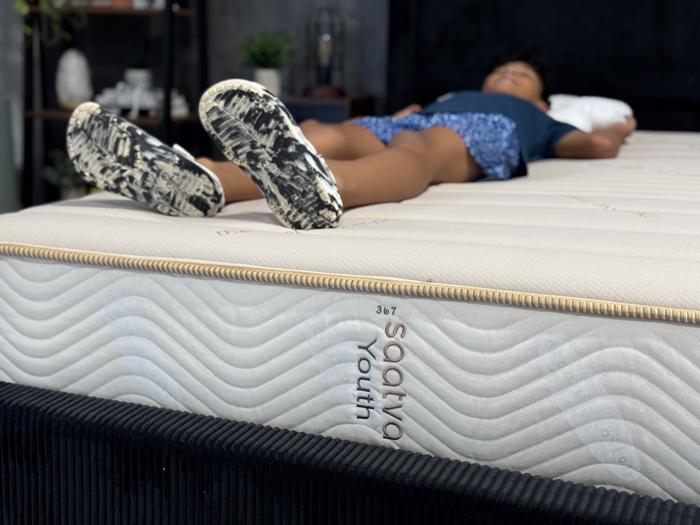
Bear Cub Kids Mattress FAQs
Is the Bear Cub Mattress good?
The Bear Cub Mattress is a well-made hybrid mattress that offers good support for healthy alignment in growing kids. It has a medium-firm that’s well suited to back and side sleepers. It also offers excellent edge support and good cooling ability.
Are Bear mattresses good for kids?
Bear offers the Cub Kids Mattress, which is specifically designed to meet the needs of smaller sleepers. Growing kids need firm support for healthy spinal alignment, and the medium-firm hybrid Bear Cub delivers. Plus, it comes with a 120-night sleep trial so you can put it to the test at home.
What is the best mattress for kids to sleep on?
The best mattress for kids offers firm support to help maintain a neutral spine, along with good edge support for stability, and breathability to keep kids from overheating at night. The Bear Cub Kids Mattress is a great option with its medium-firm feel, excellent edge support, and cooling hybrid construction.
How firm should a mattress for kids be?
Kids generally benefit from a firmer mattress that supports healthy spinal alignment as they grow. Younger kids between 2 and 7 years old do best with a firm bed, while kids ages 8 and 12 may prefer something slightly softer to better balance comfort and support.
